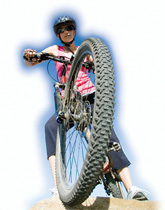
Brightly painted cruiser-style bikes, outfitted with rear baskets and bells, silently pass each other in the warm, inviting air. They glide across the cut, around the dorms, and even down the hallways. It seems that someone has forgotten to tell the campus riders that it is well past midnight.
Sophomore Kelly Cahill’s friend—Nicholas Wolff, a sophomore information systems manager—convinces her to find a replacement for her graveyard desk shift at Morewood Gardens. Perhaps they can find two of the newly minted bikes sailing out on the common. As they stroll the darkened campus, bikes pass every two to three minutes, splashes of color against the moonlit landscape.
Earlier in the day was the kickoff of the Public Rec Program Pilot Study, an initiative spearheaded by student government leaders. A key element was to distribute a fleet of 45 bikes to the campus, unmonitored and completely unsecured. Any student could take a bike from Skibo Gym to the library, where another could pick it up for a trip to the University Center. Beyond being a shared form of transportation, the fleet is meant to encourage outdoor activity, community spirit, and just plain fun. The initiative, though, sparked some campus debate over its cost and practicality. Cahill counted herself as one of the program’s critics.
But during last spring’s kickoff day, critics were hard to find. Hundreds of students swarmed across the cut to sample free Italian ice and perhaps take a turn at spray painting one of the brand-new three-speed bikes. “There were more people than I have ever seen on the cut in my entire life,” Cahill says. The original idea had been to paint the bikes tartan plaid—in red, green, yellow, and blue—but free expression took hold. The final pieces of rolling art range from a tie-dyed style creation to a solid green number, right down to its rubber tires.
Now, in the hushed hours between midnight and dawn, Cahill and Wolff continue their cycle search, spotting bikes “everywhere, but none available.” After an hour’s hunt, they wander into the solitude behind Margaret Morrison. There, patiently waiting, sit two unoccupied bikes ready to roll. Cahill’s bike is decorated in Rastafarian colors and looks like an oversized Fisher Price toy. Wolff’s is a factory-painted drab blue. The two students grab their treasures and begin their bedtime ride.
Whether it was the day’s festivity or the evening’s journey to nowhere, Cahill realizes that she is no longer a rec program critic. Even when it begins to rain, Cahill and Wolff are reluctant to end the fun. After 15 soggy minutes, the pair decide it’s time to share their good time. They ride around the sidewalk compass in front of the Carnegie Mellon Cafe and stash the bikes in the bushes nearby, where they can be discovered again.



